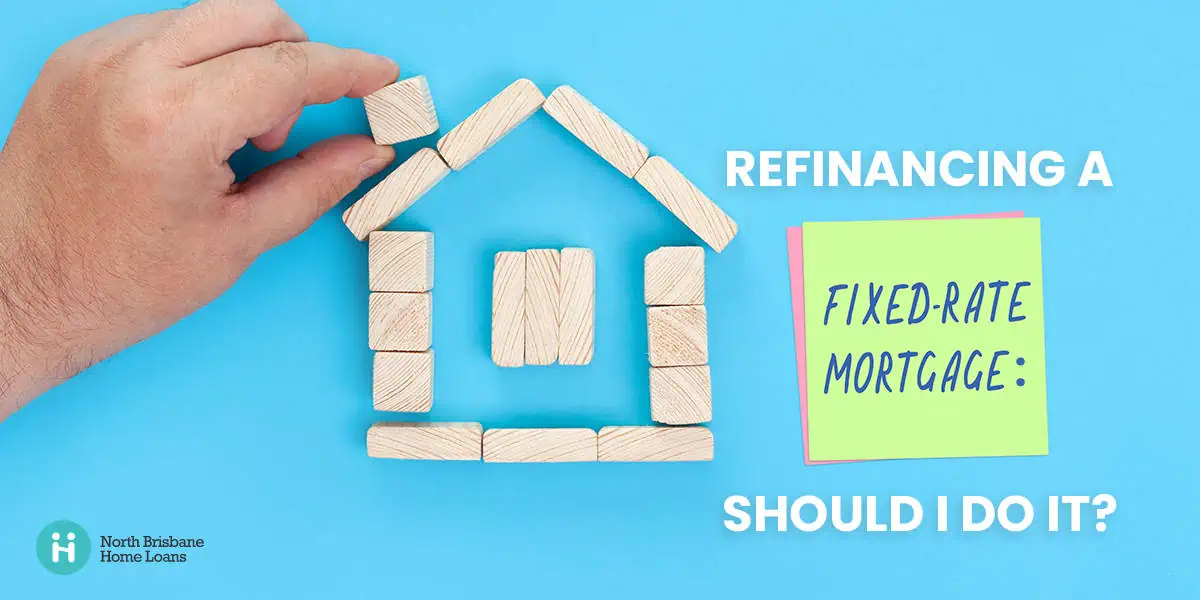Refinancing a fixed rate home loan: should I do it?
Is your current mortgage term about to end, and are you considering refinancing it? Refinancing a fixed rate home loan is a great way to secure more favourable terms and lower interest rates.
With a $141 billion wave of fixed rate home loans expiring this year, there is currently a refinancing boom among Australian homeowners with owner occupied mortgages facing a mortgage cliff. The value of new owner occupied home loans, on the other hand, are falling sharply (3.7% decline as of November 2022) according to data released by the Australian Bureau of Statistics. And it continues to decline, while the value of refinancing is steadily rising.
But before you jump the gun, there are a host of factors to consider when determining if it is the right decision for you. In this blog post, we’ll discuss everything you need to know about refinancing fixed rate home loans, and why or why not you should do it.
First, what is a fixed rate home loan?
Fixed rate loans are a popular choice among borrowers looking to refinance their mortgage. They allow borrowers to lock in a steady interest rate for the life of the loan, providing them with more stability than an adjustable-rate mortgage or variable-rate mortgage, but with less flexibility. This type of loan is ideal for people who want to maintain cashflow certainty, have a long-term plan, and can afford to pay a higher interest rate.
The costs of fixed rate home loans are typically more expensive than a variable rate loan, but the stability it provides can be worth the extra cost. If you’re considering refinancing your home loan with a fixed mortgage rate, be sure to do a fixed rate home loan comparison from different lenders, or ask specialists like a mortgage broker to do it for you.
What happens at the end of a fixed rate term?
At the end of a fixed rate term, your fixed rate period will expire, and your loan will typically revert to the lender’s standard variable rate (SVR). This is unless you choose to refinance or negotiate a new fixed rate term with your lender.
The standard variable home loan refinance rates can be higher or lower than your fixed rate, and it can also fluctuate over time as the lender adjusts their interest rates in response to market conditions.
Once your loan reverts to the SVR, you’ll have the option to continue making the same repayments as you did during the fixed rate period, which could mean paying more than the minimum repayment required by the lender. Alternatively, you could choose to reduce your repayments to the minimum required, which could result in a longer loan term and higher overall interest costs.
HOWEVER – as most loans are currently coming off lower rates and going to a higher rate – your repayments are likely to increase, and would normally be set at the minimum payments required to see your loan cleared within the original loan term. IE: If you had a 30 yr loan term and you are 3 yrs in – remaining payments would be scheduled over the remaining 27 yr term.
Before the end of the fixed rate term, your lender will typically contact you to discuss your options for the next stage of your loan documentation. This can include:
- negotiating a new fixed rate term
- switching to a different loan product with your current lender, or
- giving you their normal variable rate without applying any level of real discount.
Can you refinance a fixed loan?
Can I refinance a fixed rate mortgage?
This is a question we are often asked by our clients. Of course this can be done, but it may come with costs and considerations depending on your circumstances and the amount you initially borrowed. Doing it means essentially breaking the existing fixed rate contract which could warrant break fees or exit fees from your current lender.
Also keep in mind that fixed rate loans as a general rule have in the past a higher interest rate than some competitive variable rate loans, so depending on the current market conditions and your choice of lender, you might not reap the benefits you were hoping for. You should also evaluate if your financial situation has changed for the better or worse, as your ability to refinance depends heavily on it.
Right now during 2023 with Fixed rates lower – you would probably not refinance until it comes off fixed – why would you?Unless you were looking to get access to equity and needed to move to another bank due to other reasons like serviceability or other reasons that force you to break your lower rate loan. And if this was the case – as the lender is replacing the loan with a higher rate – it would be unlikely for an economic cost to apply – but check with your lender first of course!
How long does the process of refinancing a fixed rate mortgage typically take?
Refinancing a fixed rate mortgage to another lender typically takes between three to four weeks complete the process, and involves submitting an application to a lender, having the home valued and having them evaluate your documentation, creditworthiness and financial situation.
Once approved, the loan documents and closing details need to be prepared and signed.
Can you extend a fixed rate home loan?
It is not possible to extend a fixed rate home loan because it has a predetermined interest rate and term, which is agreed upon at the time of taking out the loan. Once the fixed rate term comes to an end, the borrower has the option to either roll to another fixed rate with the same lender, switch to a variable rate loan with the same lender or refinance the mortgage somewhere else.
It is not possible to extend a fixed rate home loan because it has a predetermined interest rate and term, which is agreed upon at the time of taking out the loan. Once the fixed rate term comes to an end, the borrower has the option to either roll to another fixed rate with the same lender, switch to a variable rate loan with the same lender or refinance the mortgage somewhere else.
Should you refinance a fixed rate home loan?
Below is a table illustrating the pros and cons of refinancing a fixed rate mortgage:
| Reasons to refinance a fixed rate home loan | Reasons NOT to refinance a fixed rate home loan: |
|
|
What are break costs and how are they calculated?
Break costs are incurred when a borrower exits a fixed rate home loan before its termination date, and they are a result of the lender losing the interest rate margin they would have received if the loan was kept until its end date.
The break costs are calculated as the difference between the interest rate on the fixed rate mortgage and the current market rate. These costs can include any early repayment fees, exit fees, and other additional costs associated with the early termination of the loan.
Note that break costs can be quite expensive and may be more than the savings from refinancing to a lower rate. Be sure to get an estimate of the break costs from your lender.
How do you avoid break costs on a fixed loan?
Refinancing a fixed rate home loan can be a great way to reduce your monthly payments and free up some extra cash. However, it does come with some costs that you should be aware of before you make the decision to refinance. Here are a few things to keep in mind when considering a refinance:
1. Choose a shorter fixed rate term
The shorter your fixed rate term, the lower your break costs are likely to be if you need to exit early. This is because the lender will have less time to earn interest on your loan at the fixed rate.
2. Consider a split loan
A split loan involves dividing your loan into fixed and variable rate components. This gives you the flexibility to pay off the variable portion of your loan faster, which can reduce the impact of break costs if you need to exit the fixed rate portion early.
3. Negotiate with your lender
If you’re experiencing financial hardship or other circumstances that make it difficult for you to meet your loan repayments, it’s worth contacting your lender to discuss your options. They may be willing to waive or reduce break costs if it means they can retain you as a customer. Some lenders may also be willing to do this if you can demonstrate that the refinance will benefit them.
4. Wait until the end of the fixed rate term
This will eliminate the risk of break costs altogether and give you more time to consider your options for refinancing or negotiating new interest rates and term with your lender.
Need further guidance? We can help
At North Brisbane Home Loans, we will analyse your current mortgage including assessing the interest rate, the loan term, the monthly repayments, and any fees or charges associated with the loan. We will take time to discuss with you what your financial goals are, and how refinancing a fixed rate home loan may or may not fit into them.
Our North Brisbane mortgage brokers are all about helping clients make informed decisions and achieve their objectives. Book a call with us today by clicking the button below.

Patrick Cranshaw, a Certified Mortgage Professional for over 21 years, founded North Brisbane Home Loans in 2002. His career began with ANZ Bank in New Zealand, where he progressed over 16 years to a Business Banking role in Virginia. After moving to Brisbane in 2000, Patrick led the QLD market for a home loan agency, helped set up the REMAX Real Estate Finance division, and practiced as a broker.









